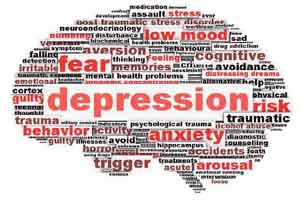- Home
- Editorial
- News
- Practice Guidelines
- Anesthesiology Guidelines
- Cancer Guidelines
- Cardiac Sciences Guidelines
- Critical Care Guidelines
- Dentistry Guidelines
- Dermatology Guidelines
- Diabetes and Endo Guidelines
- Diagnostics Guidelines
- ENT Guidelines
- Featured Practice Guidelines
- Gastroenterology Guidelines
- Geriatrics Guidelines
- Medicine Guidelines
- Nephrology Guidelines
- Neurosciences Guidelines
- Obs and Gynae Guidelines
- Ophthalmology Guidelines
- Orthopaedics Guidelines
- Paediatrics Guidelines
- Psychiatry Guidelines
- Pulmonology Guidelines
- Radiology Guidelines
- Surgery Guidelines
- Urology Guidelines
How depression and antidepressant drugs works: Research

New research demonstrates the effectiveness of ketamine to treat depression in a mouse model of the disease and brings together two hypotheses for the cause of depression. The research, led by Bernhard Lüscher, professor of biology and of biochemistry and molecular biology at Penn State University, is in press and will be published in the September 15, 2016 print edition of the journal Biological Psychiatry.
"Depression is the second most expensive health problem that we face worldwide, but this fact is not very well known because there is a stigma attached to depression and people don't like to talk about it," said Lüscher. "About 17 percent of Americans will be treated for depression at some point in their lives, but there are limited treatment options and about one-third of patients do not respond to these treatments."
Lüscher and his colleagues generated a mouse model for depression by introducing a mutation into a gene that codes for one of the subunits of a receptor for GABA the second most abundant chemical used by nerve cells in the brain to communicate. GABA functions mainly to reduce the activity of nerve cells. The receptor mutation results in a reduction in GABA signaling of about 15 to 20 percent and mimics reductions in GABA signaling seen in patients with depression. The mice that have the mutation exhibit traits associated with depression, such as reduced pleasure seeking, and they become normal again following treatment with antidepressant medications.
"You can think of GABA as acting like the brakes of a car its function is to slow activity in nerve cells," said Lüscher. "Its counterpart is glutamate, another signaling chemical in the brain that acts as the accelerator of nerve cell activity. When we reduced the function of GABA in our mice, we were surprised to see that the level of glutamate was also reduced. This result suggests that the brain has mechanisms that maintain a balance between the brakes and the accelerator to prevent brain activity from going out of control, a state we refer to as homeostasis."
The researchers treated the mice with low doses of ketamine, an experimental antidepressant drug known to act by transiently blocking a major class of glutamate receptors in nerve cells. "Treatment with ketamine not only normalized the behavior and brought glutamate receptor levels back up to normal in our mice, but GABA function also was restored," said Lüscher. Importantly, the effects of ketamine were only observed in mice with the receptor mutation where nerve signaling was defective, and not in normal mice. "Our results bring together the hypothesis that depression results from deficits in GABA signaling and the hypothesis that depression results from deficits in glutamate signaling. We showed that the depression-like behavior in our mice results from the reduction of both GABA and glutamate, and importantly, that both can be restored with a single dose of ketamine."
The researchers plan to use their mouse model to better understand how ketamine functions to develop safer alternatives. "Ketamine has many advantages over currently used antidepressant medications," said Lüscher. "It acts quickly and has long lasting effects, but it is addictive and can induce psychosis, so we hope to use our model to better understand how ketamine works biochemically. We can then begin to develop ketamine-like drugs without the unwanted side effects."
You can read the full article by clicking on the following link:
Zhen Ren, Horia Pribiag, Sarah J. Jefferson, Matthew Shorey, Thomas Fuchs, David Stellwagen, Bernhard Luscher. Bidirectional Homeostatic Regulation of a Depression-Related Brain State by Gamma-Aminobutyric Acidergic Deficits and Ketamine Treatment. Biological Psychiatry, 2016; DOI: 10.1016/j.biopsych.2016.02.009

Disclaimer: This site is primarily intended for healthcare professionals. Any content/information on this website does not replace the advice of medical and/or health professionals and should not be construed as medical/diagnostic advice/endorsement or prescription. Use of this site is subject to our terms of use, privacy policy, advertisement policy. © 2020 Minerva Medical Treatment Pvt Ltd